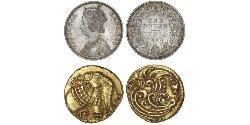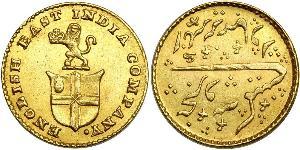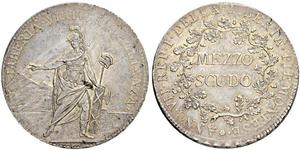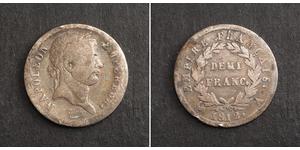1/3 Mohur
1820, British India, Madras Presidency. Gold 5 Rupees (1/3 Mohur) Coin. NGC MS61!
Mint Year: 1820
Colony: British East India
Provenance: ex. Blaine Collection.
Reference: Friedberg 1590, KM-422. R!
Denomination: Gold 5 Rupees (1/3 Mohur)
Condition: Certified and graded by NGC as MS-61!
Diameter: 17mm
Weight: 3.88gm
Material: Gold!
Obverse: Arms of the East india company (lion left, holding crown, standing on british shield).
Legend: BRITISH EAST INDIA COMPANY .
Reverse: Persian inscription.
Translated: "Of the Honorable English Company."
The East India Company (also the East India Trading Company, English East India Company, and sometimes the British East India Company,) was an early English joint-stock company that was formed initially for pursuing trade with the East Indies, but that ended up trading with the Indian subcontinent and China. The oldest among several similarly formed European East India Companies, the Company was granted an English Royal Charter, under the name Governor and Company of Merchants of London Trading into the East Indies, by Elizabeth I on 31 December 1600. After a rival English company challenged its monopoly in the late 17th century, the two companies were merged in 1708 to form the United Company of Merchants of England Trading to the East Indies, commonly styled the Honourable East India Company, and abbreviated, HEIC; the Company was colloquially referred to as John Company, and in India as Company Bahadur ("bahadur": Hindustani, lit. "brave").
The East India Company traded mainly in cotton, silk, indigo dye, saltpetre, tea, and opium. However, it also came to rule large swathes of India, exercising military power and assuming administrative functions, to the exclusion, gradually, of its commercial pursuits. Company rule in India, which effectively began in 1757 after the Battle of Plassey, lasted until 1858, when, following the events of the Sepoy Rebellion of 1857, and under the Government of India Act 1858, the British Crown assumed direct administration of India in the new British Raj. The Company itself was finally dissolved on 1 January 1874, as a result of the East India Stock Dividend Redemption Act.
Madras Presidency, also known as Madras Province and known officially as Presidency of Fort St. George, was a province of British India.
The Presidency had its origins in the Agency of Fort St George established by the British East India Company soon after the purchase of the village of Madraspatnam in 1639. However, there have been Company factories at Machilipatnam and Armagon ever since the early 1600s. Madras was upgraded to a Presidency in 1652 before reverting to its previous status as an Agency. In 1684, Madras was elevated to a Presidency once again and Elihu Yale appointed its first President. From 1785 onwards, as per the provisions of the Pitt's India Act, the ruler of the Presidency of Fort St George was styled ''Governor'' instead of ''President'' and was made subordinate to the Governor-General at Calcutta. Madras made a significant contribution to the freedom movement in the early decades of the 20th century. Madras was the first province in British India where the system of dyarchy was first implemented. The Presidency was dissolved when India became independent on August 15, 1947. On January 26, 1950, when the Republic of India was inaugurated, Madras was admitted as one of the states of the Indian Union.
Madras was one of the three provinces originally established by the British East India Company as per the terms of the Pitt's India Act. The head of state held the title of "Agent" from 1640 to 1652 and 1655 to 1684 and President from 1652 to 1655 and 1684 to 1785 and Governor from 1785 to 1947. The judicial, legislative and executive powers are wrested in the Governor who is assisted by a Council whose constitution has been modified by reforms enacted in 1861, 1909, 1919 and 1935. As per the Montague-Chelmsford reforms of 1919, a system of dyarchy was established and regular elections were conducted till the outbreak of the Second World War. The head of the government was known as Prime Minister. In 1908, the province comprised 22 districts each under a District Collector. Each district was further sub-divided into ''taluks'' and ''firqas''. The smallest unit of administration was the village.
Only 1$ shipping on each additional item purchased!

spa1 » Incredible India (48 钱币)
Indian history has deep roots. The earliest coins from native Indian people I found are belong to Kushan Empire (30–375). You can find couple of them below as well as other ancient India civilizations like Chalukya and Mughal Empires. In 149 ...

|
发布人:
anonymous 2023-10-31 |
|
||
|
||
|
||
|
||
1/2 Scudo 教皇国 (754 - 1870) 銀
本组有 3 钱币 / 3 售价
⇑
1/2 Franc 法兰西第一帝国 (1804 - 1814) 銀 拿破仑一世(1769 - 1821)
本组有 15 钱币 / 14 售价
⇑




 Deutsch
Deutsch Русский
Русский Українська
Українська English
English Italiano
Italiano Français
Français Español
Español 汉语
汉语




-300-150-hMc22nImZq0AAAF45igcj4bn.jpg)

-300-150-e24KbzbiOVkAAAFL68Sjlth6.jpg)






